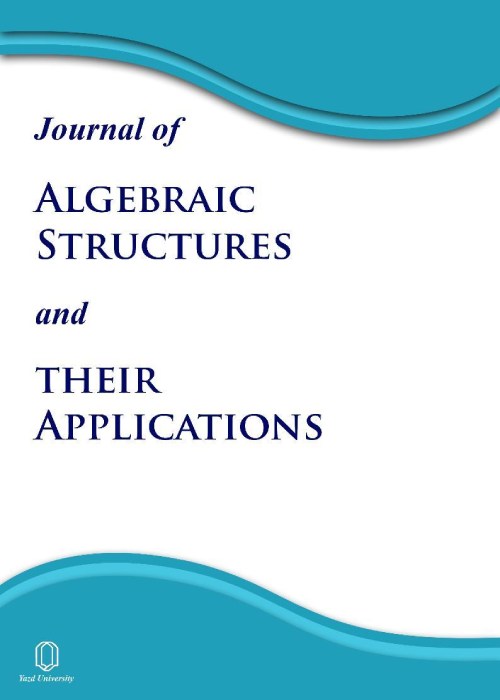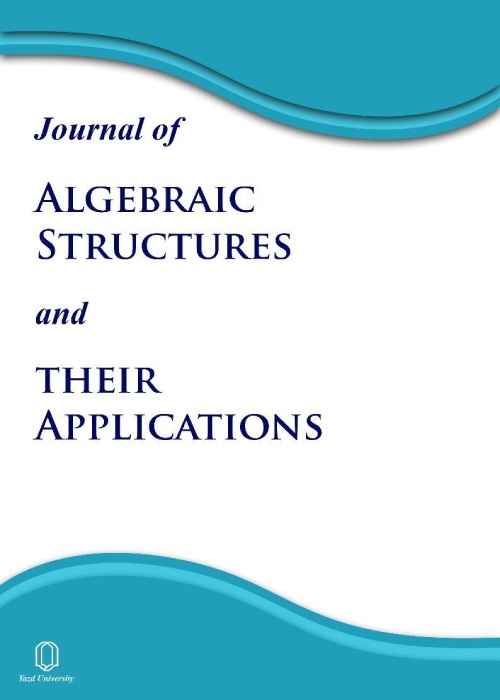فهرست مطالب

Journal of Algebraic Structures and Their Applications
Volume:10 Issue: 1, Winter-Spring 2023
- تاریخ انتشار: 1401/11/12
- تعداد عناوین: 12
-
-
Pages 1-15In this article, we first consider concept of small Noetherian dimension of a module, which is dual to the small krull dimension, denoted by $sn{\rm -dim}\, A$, and defined to be the codeviation of the poset of the small submodules of $A$. We prove that if an $R$-module $A$ with finite hollow dimension, has small Noetherian dimension, then $A$ has Noetherian dimension and $ sn{\rm -dim}\, A\leq n{\rm -dim}\, A\leq sn{\rm -dim}\, A+1$. Last we introduce the concept of $\alpha$-small short modules, i.e., for each small submodule $S$ of $A$, either $n{\rm -dim}\, S \leqslant \alpha$ or $sn{\rm -dim}\,\frac{A}{S}\leqslant\alpha$ and $\alpha$ is the least ordinal number with this property and by using this concept, we extend some of the basic results of short modules to $\alpha$-small short modules. In particular, we prove that if $A$ is an $\alpha$-small short module, then it has small Noetherian dimension and $sn{\rm -dim}\, A=\alpha$ or $sn{\rm -dim}\, A=\alpha+1$. Consequently, we show that if $A$ is an $\alpha$-small short module with finite hollow dimension, then $\alpha\leq n{\rm -dim}\, A\leq\alpha+2$.Keywords: Small Noetherian dimension, Hollow dimension, Small short modules, Small atomic module
-
Pages 17-38In this paper, the properties of GE-ideals of transitive bordered GE-algebra are studied and characterizations of GE-ideals are given. We have observed that the set of all GE-ideals of a transitive bordered GE-algebra forms a complete lattice. The notion of bordered GE-morphism is introduced and established fundamental bordered GE-morphism theorem. A congruence relation on a bordered GE-algebra with respect to GE-ideal is introduced and some bordered GE-morphism theorems are derived.Keywords: Bordered GE-algebra, GE-ideal, Bordered GE-morphism, Dual kernel
-
Pages 39-46A setosa graph $SG(e,f,g,h,d;b_1,b_2,\ldots,b_s)$ is a graph consisting of five cycles and $s(\geq 1)$ paths $P_{b_1+1}, P_{b_2+1},\ldots,P_{b_s+1}$ intersecting in a single vertex that all meet in one vertex, where $b_i\geq1$ (for $i=1,\ldots,s$) and $e,f,g,h,d\geq 3$ denote the length of the cycles $C_e$, $C_f$, $C_g$, $C_h$ and $C_d$, respectively. Two graphs $G$ and $H$ are $L$-cospectral if they have the same Laplacian spectrum. A graph $G$ is said to be determined by the spectrum of its Laplacian matrix (DLS, for short) if every graph with the same Laplacian spectrum is isomorphic to $G$. In this paper we prove that if $H$ is a $L$-cospectral graph with a setosa graph $G$, then $H$ is also a setosa graph and the degree sequence of $G$ and $H$ are the same. We conjecture that all setosa graphs are DLS.Keywords: DLS graphs, Laplacian matrix, Laplacian spectrum, $L$-cospectral graphs, Setosa graph
-
Pages 47-55In this paper, we prove that every element in an exchange ring $R$ with artinian primitive factors is $n$-tuplet-good iff $1_R$ is $n$-tuplet-good. Also, we show that for such rings the full matrix ring $M_n(R)$ (for $n\geq 2$) is $n$-tuplet-good. In [7], Fisher and Snider proved that every element of a strongly $\pi$-regular ring $R$ with $\frac{1}{2}\in R$ is 2-good. We prove the same result under new condition and show that these rings are twin-good. We also consider the conditions under which endomorphism ring of a finitely generated projective module $M$ over unit regular ring $L$ is 2-tuplet-good. The main result of [14] states that regular self-injective rings are $n$-tuplet-good if such rings has no factor ring isomorphic to a field $D$ with $|D|<n+2$. We generalized this result to regular Baer rings proving that every regular Baer ring $R$ that has no factor ring isomorphic to a field of order less than $n+2$, is $n$-tuplet-good.Keywords: Baer ring, Exchange ring, $n$-tuplet-good ring, Strongly $pi-$regular ring, Twin-good ring
-
Pages 57-72In this paper, we study the $\sim_{n}$ notion of conjugacy in semigroups. After proving some basic results, we characterize this notion in subsemigroups of $\mathcal{P}(T)$ (partial transformation semigroup) and $\mathcal{T}(T)$ (transformation semigroup) through digraphs and their restrictive partial homomorphisms.Keywords: Conjugacy, connected, Digraphs, Maps, Rp-hom
-
Pages 73-85The power graph $\mathcal{P}(G)$ of a finite group $G$ is a graph whose vertex set is the group $G$ and distinct elements $x,y\in G$ are adjacent if one is a power of the other, that is, $x$ and $y$ are adjacent if $x\in \langle y\rangle$ or $y \in \langle x\rangle$. In this paper, we study existence of the Hamilton cycle in the power graph of some finite nilpotent groups $G$ with a cyclic subgroup as direct factor when $G$ is written as direct product Sylow $p$-subgroups. For this purpose we use of cartesian product a spanning tree and a cycle. Finally, we determined values of $n$ such that $\mathcal{P}(U_n)$ is Hamiltonian, where $U_n$ is a group consist of all positive integers less than $n$ and relatively prime to $n$ under multiplication modulo $n$.Keywords: Cartesian Product, Hamilton cycle, Power graph, Spanning Tree
-
Pages 87-93We call $G$ to be an $\alpha$-coset group, if it contains a proper $\alpha$-invariant normal subgroup $N$ such that $Nx^\alpha =\{x^g~|~ g\in G\}$, for some automorphism $\alpha$ of $G$ and any $x \in G\setminus N$. Clearly, if $\alpha$ is identity automorphism of $G$, one obtains the notion of con-cos groups, which was first introduced by Muktibodh in 2006.In the present article, we discuss some properties of the new notion. Also, we introduce the concept of $\alpha$-Camina groups and give its connection with the groups of property $\mathcal P$, where $\mathcal P$ is the class of all finite groups such that their $\alpha$-centres are the same as $\alpha$-commutator subgroups of order $p$.Keywords: Absolute centre, $alpha$-centre, $alpha$-commutator subgroup, Central automorphism, Left, right $alpha$-commutator
-
Pages 95-112In this paper, we study Tychonoff spaces and uniformities on MV-algebras. In particular, we find some conditions under which an MV-algebra can be made into a Tychonoff space. Also, we find uniformities that make an MV-algebra into a uniform MV-algebra. Next, we discuss some algebraic and topological properties of uniform MV-algebras. More precisely, we study the existence of closed ideals and closed filters, and examine the way these are related to uniform MV-algebras. Furthermore, we obtain some results on the uniform continuity of the operations and its consequences.Keywords: Filter, ideal, MV-algebra, Tychonoff space, Uniformity
-
Pages 113-130In this paper we introduced the concept of minimal prime filters in commutative $BE$-algebras. A characterization theorem for minimal prime filters of $BE$-algebras is derived. Some properties of minimal prime filters of a commutative $BE$-algebras are derived with the help of congruences. A necessary and sufficient is derived for a pair of minimal prime filters to become co-maximal.Keywords: Commutative $BE$-algebra, Congruence, Minimal prime filter, Prime filter
-
Pages 131-139For a commutative ring $R$, the compressed annihilator graph $AG_E(R)$ is defined by, taking the equivalence classes of zero divisors of $R$ as the vertex set and two distinct vertices $[a]$ and $[b]$ are adjacent if and only if $ ann(a) \cup ann (b) \subset ann(ab)$. In this paper, we discuss some of the basic properties such as degree of the vertices, Eulerian, regularity, domination number and planarity of $AG_E(\mathbb{Z}_n)$, where $\mathbb{Z}_n$ is the ring of integer modulo $n$.Keywords: Compressed annihilator graph, Domination polynomial, Eulerian, Planarity
-
Pages 141-149Let $R$ be a commutative ring and $M$ be an $R$-module. The $M$-intersection graph of ideals of $R$, denoted by $G_M(R)$ is a graph with the vertex set $I(R)^*$, and two distinct vertices $I$ and $J$ are adjacent if and only if $IM\cap JM\neq 0$. In this paper, we study $G_{R/J}(R/I)$, where $I$ and $J$ are ideals of $R$ and $I\subseteq J$. We characterize all ideals $I$ and $J$ for which $G_{R/J}(R/I)$ is planar, outerplanar or ring graph.Keywords: Intersection graph, Outerplanarity, Planarity, Ring graph
-
Pages 151-164In this paper we shall introduce a theory of length for Artinian modules over an arbitrary ring (with identity), assigning to each Artinian module $A$ an ordinal number $len(A)$ which will briefly be called the length of $A$. We also demonstrate for some familiar properties of left Artinian ring be proved efficiently using length and arithmetic properties of ordinal numbers.Keywords: Artinian module, Length dimension, Length function, Length rank, Strictly increasing function


